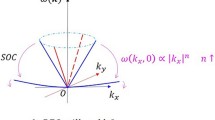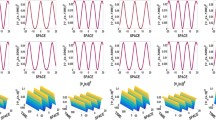We solve a model which describes internal degrees of freedom of the spinor Bose–Einstein condensate with dipole-dipole interaction up to its eigenstates and eigenvalues. A representation of the Hamiltonian of the model in terms of generators of the su(1, 1) algebra allows one to develop the quantum inverse method for its study. The method of solution provides a general framework within which many related problems can be solved similarly. Bibliography: 15 titles.
Similar content being viewed by others
References
C. K. Law, H. Pu, and N. P. Bigelow, “Quantum spin mixing in spinor Bose-Einstein condensates,” Phys. Rev. Lett., 24, 5257 (1998).
H. Pu, C. K. Law, S. Raghavan, J. H. Eberly, and N. P. Bigelow, “Spin-mixing dynamics of a spinor Bose-Einstein condensate,” Phys. Rev. A, 60, 1463(1999).
Ö. E. Müsteapliogglu, M. Zhang, S. Yi, L. You, and C. P. Sun, “Dynamic fragmentation of a spinor Bose-Einstein condensate,” Phys. Rev. A, 68, 63616 (2003).
S. Yi, L. You, and H. Pu, “Quantum phases of dipolar spinor condensates,” Phys. Rev. Lett., 93, 040403 (2004).
M. Takahashi, Sankalpa Ghosh, T. Mizushima, and K. Mahida, “Spinor dipolar Bose-Einstein condensates: Classical spin approah,” Phys. Rev. Lett., 98, 260403(2007).
T. Lahaye, J. Metz, T. Koh, B. Fröhlih, A. Griesmaier, and T. Pfau, “A purely dipolar quantum gas,” in: Atomic Physics 21, Proc. XXI Intern. Conf. of Atomic Phiysics (ICAP2008).
S. Yi and H. Pu, “Dipolar spinor Bose-Einstein condensates,” arXiv:0804.0191v1 (2008).
E. K. Sklyanin, L. A. Takhtajan, and L. D. Faddeev, “Quantum inverse problem method. I,” Teor. Mat. Fiz., 40, 688 (1979).
V. E. Korepin, N. M. Bogoliubov, and A. G. Izergin, Quantum Inverse Scattering Method and Correlation Functions, Cambridge Univ. Press, Cambridge (1993).
N. M. Bogoliubov, “Spinor Bose condensate and su(1,1) Richardson model,” Zap. Nauchn. Semin. POMI, 317, 43 (2004).
A. Rybin, G. Kastelewicz, J. Timonen, and N. Bogoliubov, “The su(1,1) Tavis-Cummings model,” J. Phys. A, 31, 4705 (1998).
C. Gerry and A. Benmoussa, “Two mode coherent states for SU(1,1)⨂ SU(1,1),” Phys. Rev. A, 62, 033812 (2000).
R. W. Richardson, “Exactly solvable many-boson model,” J. Math. Phys., 9, 1327 (1968).
M. Gauden, La Fonction D'onde de Bethe, Masson, Paris (1983).
E. W. Hobson, The Theory of Spherical and Ellipsoidal Harmonics, Cambridge Univ. Press, Cambridge (1931).
Author information
Authors and Affiliations
Corresponding author
Additional information
Translated from Zapiski Nauchnykh Seminarov POMI, Vol. 374, 2010, pp. 5–27.
Rights and permissions
About this article
Cite this article
Abarenkova, N.I., Bogoliubov, N.M. Solution of an integrable model of the spinor Bose–Einstein condensate with dipole-dipole interaction. J Math Sci 168, 759–771 (2010). https://doi.org/10.1007/s10958-010-0024-9
Received:
Published:
Issue Date:
DOI: https://doi.org/10.1007/s10958-010-0024-9




